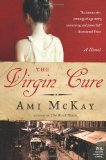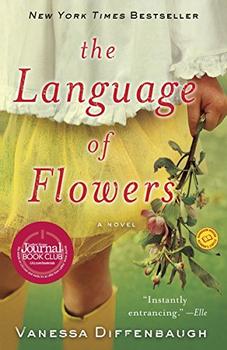Summary | Excerpt | Reading Guide | Reviews | Beyond the book | Read-Alikes | Genres & Themes | Author Bio

A Novel
by Ami McKayHistorical fiction is a genre with which I am developing a fuller and more positive relationship. Based on past reading experiences, I had previously avoided this area of literature thinking it too dry or, even worse, too gushy and unrealistically romantic. But then, through a few excellent selections by my in-person book group, I began to really love historical fiction and also began to actively seek it out when making my reading choices.
In 2006, I read The Birth House by Ami McKay. A-HA! This was great historical fiction! (The novel was a national bestseller in Canada and was longlisted for the 2008 International IMPAC Dublin Literary Award.) When I heard McKay had another book being released, I was so excited and couldn't wait to immerse myself in it. The Virgin Cure does not disappoint! Like The Birth House, it encompasses everything I want in a story: well developed and realistic characters, rich and layered settings and a very compelling narrative. I didn't feel smacked in the face by an author trying to cram an overwhelming amount of research into their story. (A sensation I have experienced several times while reading historical fiction. When this happens, the research becomes very obvious, and I am taken out of the story.)
This novel is so vivid. In reading McKay's words, I felt as though I could see, hear, touch and smell the world of Lower Manhattan in 1871. The story follows a brief and chaotic year in the life of twelve-year-old Moth Fenwick. Moth's voice grabs attention from the first line: "I am Moth, a girl from the lowest part of Chrystie Street, born to a slum-house mystic and the man who broke her heart." Immediately I felt a protectiveness of Moth and read the story with the hope she would emerge from her lot in life with as little damage as possible.
The slice of life McKay introduces to readers is bleak. The people living in the slums of New York City seem fated to desperation and struggle for survival. "Boys grew into guttersnipes, then pickpockets, then roughs... Girls sold matches and pins, then flowers and hot corn and then themselves." But Moth is a feisty and determined girl and far less naive than a twelve-year-old should be. She has very modest dreams and plans to escape her mother and their life when she turns thirteen. Fully realizing that she, as a young girl, is a commodity - whether sold by her mother to work as a servant for well-to-do families, or selling her virginity to the highest bidder - "It was never a question of yes or no. It was simply a matter of which man would have you first." Moth's wish is to be in control of her own life and negotiate the world on her own terms, even though her options seem very limited.
Moth's mother preempts her daughter's escape plans by selling her into service to Mrs. Wentworth, a woman who turns out to be cruel and irrational. Not wanting to disappoint her mother or lose their source of financial support, Moth endures vicious treatment and abuse at the hands of Mrs. Wentworth. After one particularly brutal attack, Moth realizes she must leave the house in order to save herself further harm. After her mother abandons her, and always in the mindset of a survivor, Moth becomes another homeless child trying to eke out a living on the streets of the Bowery.
During this time, Moth meets Miss Everett, known for running an excellent brothel (as far as these things go, I suppose). She caters to a clientele who pay a premium for the virginity of the girls she has trained. Moth realizes this is not an ideal situation but sees this choice as a means to an end and a way to fulfill her dreams of escape. Through Miss Everett Moth meets Dr. Sadie, a female physician, and finally we have a character with a voice of reason who tries to protect Moth and recognizes the magnitude of problems facing women in the slums of New York. Dr. Sadie tries to offer an alternative life to Moth, tries to let her know she can provide Moth a different path to follow. Dr. Sadie also offers the young girl an education in health, hygiene and disease.
The title of the book may be a curiosity to some. The Virgin Cure references a misguided and harmful belief that men suffering from syphilis could sleep with a virgin and be cured of their disease. Through the voices of Moth and Dr. Sadie we come to learn how extensive this belief is and how tragic the outcomes are.
While much of my description of the book and the information in this review may seem dark or heavy, The Virgin Cure is to be commended for addressing a difficult subject with humanity and in a way that is very accessible to readers. This story is full of life, and the will of a young girl to find a better way in the world than the one she knows is so strong on every page. McKay doesn't make Moth's journey easy, and that is to her credit. Moth must travel the path set out from her birth. That she does so wisely and with her eyes open - despite enduring pain, loss, and sadness - makes the experience of reading The Virgin Cure so much more real. Moth will take up space in your heart, and you will thank McKay for the gift of this story.
![]() This review was originally published in The BookBrowse Review in June 2012, and has been updated for the
July 2013 edition.
Click here to go to this issue.
This review was originally published in The BookBrowse Review in June 2012, and has been updated for the
July 2013 edition.
Click here to go to this issue.

If you liked The Virgin Cure, try these:

by Robin Oliveira
Published 2019
From the New York Times bestselling author of My Name Is Mary Sutter comes a rich and compelling historical novel about the disappearance of two young girls after a cataclysmic blizzard, and what happens when their fate is discovered.

by Vanessa Diffenbaugh
Published 2012
A mesmerizing, moving, and elegantly written debut novel, The Language of Flowers beautifully weaves past and present, creating a vivid portrait of an unforgettable woman whose gift for flowers helps her change the lives of others even as she struggles to overcome her own troubled past.
Your guide toexceptional books
BookBrowse seeks out and recommends the best in contemporary fiction and nonfiction—books that not only engage and entertain but also deepen our understanding of ourselves and the world around us.